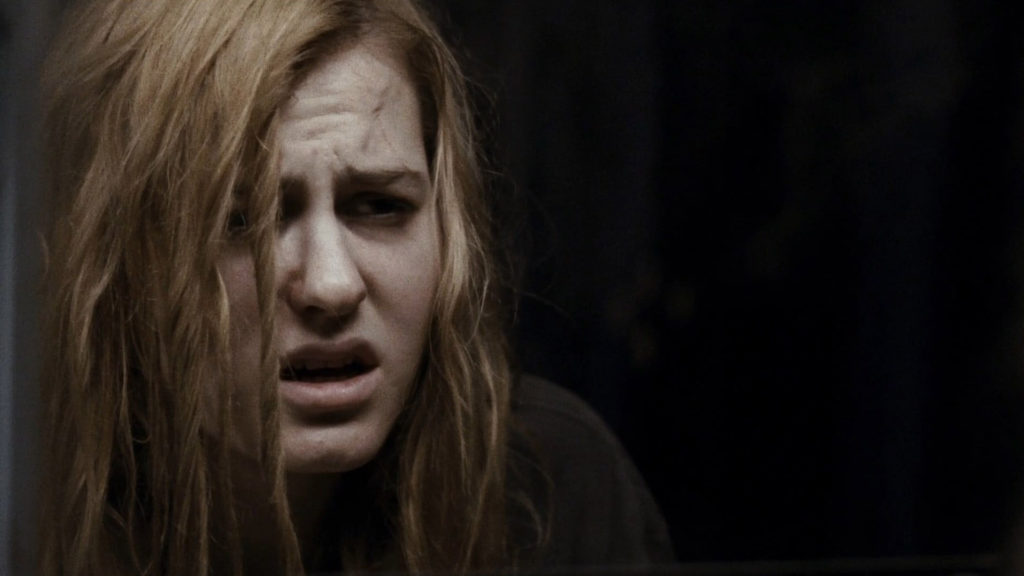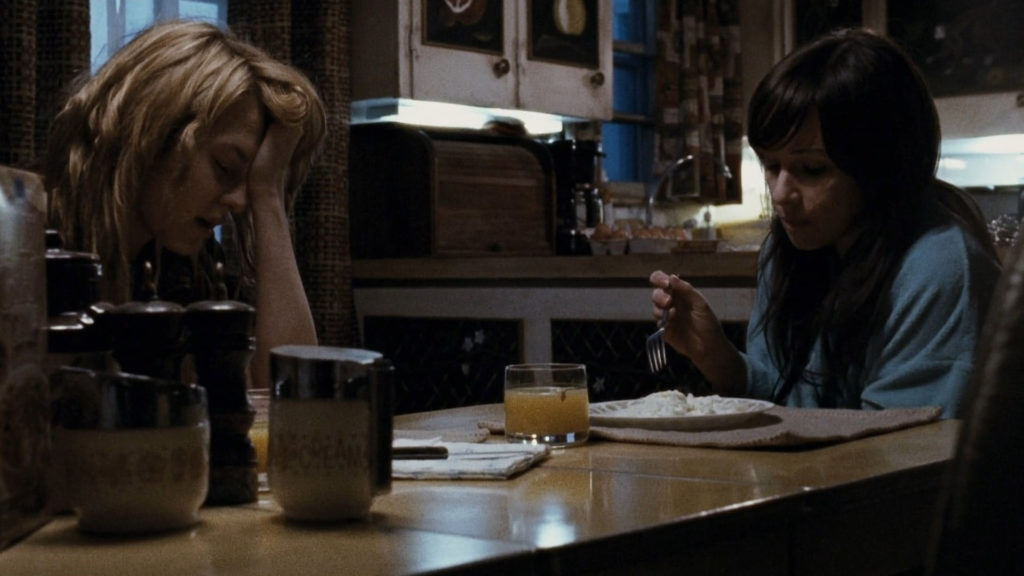Halloween II opens with a middle finger. I haven’t encountered anyone who thinks that the first Rob Zombie Halloween was at its best when it was slavishly mimicking the beats of the 1978 original in its second half. I certainly don’t. And I suspect Zombie knew this.
So Halloween II taunts us by using its opening 20 minutes to show Michael Myers (Tyler Mane) chasing down and horrifically attacking Laurie Strode (Scout Taylor-Compton) in a hospital as she recovers from his initial attacks as seen in the previous film… which, you’ll recall, is exactly the premise of the original Halloween II from 1981. Are we due for another beat-by-beat retread? Nope! Poof, it was all a dream! We’re actually two years in the future, and Laurie has PTSD nightmares! (Note: I watched the Director’s Cut of this film, whereas the Theatrical Cut reportedly fudges the timeline to make it one year.)
I tend to think that dream sequences used as rug pulls to trick the viewers are stupid, and this is no exception. I wish this opening wasn’t a mere figment of Laurie’s imagination. But it at least has purpose; the sequence does three really important things: The first is that its sheer brutality serves as a warning to the audience that this is going to be the cruellest, most bone-crunching, flesh-ripping, viscerally violent Halloween film yet — the opening is gruesomely gory. The second purpose of the intro is that it sets up one of the film’s key themes: Her hospital room is invaded, as is her restful slumber; throughout Halloween II, all the places that Laurie holds safe will be literally and figuratively a danger to her — hospital, dream, and otherwise. Of course, this is not the first Halloween to plumb dread and irony from safe spaces turned inside out, but its especially potent. And the third purpose of this intro is for us to meet, full throttle from the outset, the most daunting and terrifying Michael Myers that has or will ever be put to film. Mane’s towering, brutish frame makes it genuinely plausible that this man can crush humans with his bare hands and survive bullets and stabs.
The last outcome of this intro, I suppose, is to remind us of the less pleasant features of Zombie’s vision of Haddonfield. The town, as envisioned by Zombie, is an outright miserable rats den populated by cartoonish white trash. One of the opening scenes of the film features blue collar workers making casual necrophilia and anal sex jokes. And speaking of Zombie reminding us of his unpleasant aesthetics and style here… dear God, the incessant screaming; it’s so damn shrill: a ringing scourge on the eardrums.

So I still very much dislike this torture porn aesthetic of horror. But credit where it is due: Halloween II comes as close to earning that aesthetic as any film I’ve seen. There is some skin-crawling, stomach-turning thematic value in emphasizing the brutality of the violence in a murky, fucked-up world. But this persistent dourness and gore doesn’t make these films necessarily more scary or thrilling; rather, I just feel kinda bummed out I spent two hours in a nihilistic shithole.
Nonetheless, I find it admirable the way that Halloween II brings the series to one of its philosophical endpoints. In addition to being the most harrowing Halloween movie, this is the most psychologically devastating film in the franchise by a mile. It is the polar opposite of the carefree Halloween: Resurrection, which is a satiric thrill ride; each victim little more than a fleshy prop to be stabbed in some darkly comic way. Here, the suffering clings to you and debilitates you like food poisoning or a bad hangover.
The Halloween series has had its share of unforgettable final scenes: the original, Halloween II (1981), Halloween 4, and Halloween H20 all have some claim on the series best ending. You can add this film to that list. The final showdown between Myers and Laurie is unexpectedly hallucinatory and perfectly constructed. It has so much gravity and finality to it: it’s tragic and anti-cathartic in a way that caps the Zombie films perfectly.

On the other hand, I could have done without the broad satire of exploitative true crime media via Malcolm McDowell’s Sam Loomis. McDowell is even more theatrical here than he was in the first Zombie Halloween, and given that this film is even grittier than the first, McDowell sticks out like a sore thumb. Loomis is written and acted as if he’s in a totally different genre, let alone movie. Laurie’s PTSD, too, is a bit overbearing and on the nose, but it at least aligns with the rest of the movie that’s so dark and weighty.
Certainly, this is one of the most visually effective Halloween films. Zombie brings a diverse lighting schema that contrasts grungy browns with silvery-white hallucinations. Some of his compositions are sensational: terrifically-lit and full of a disorienting, trippy glare. Long stretches of the film are over-dark and tough to follow, but that feels intentional, both for thematic purposes and to add contrast to the brighter segments.
Halloween II is not my favorite in the series. I’m not even 100% sure it’s a better movie than its cheesy 1981 namesake. But I can see why it has become the most cultishly adored film in the Halloween series among hardcore horror-heads. It swings for the fences and takes the film to daring, challenging places the series had never been before and would never go again. To offer that much payoff in the tenth movie in a series is a hell of an accomplishment.
- Review Series: Halloween
Is It Good?
Good (5/8)
Dan is the founder and head critic of The Goods. Follow Dan on Letterboxd. Join the Discord for updates and discussion.

